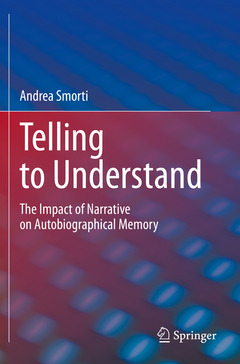Telling to Understand, 1st ed. 2020 The Impact of Narrative on Autobiographical Memory
Auteur : Smorti Andrea

This book illustrates the link that unites memory, thought, and narration, and explores how the act of telling helps people to understand themselves and others. The structure of the book is divided into two parts. The first part focuses on the aspect of narrative comprehension?the person as narrator. It identifies two different origins of narrative comprehension (memory and play) and argues that the narratives we produce starting from autobiographical memory are intended to give order and meaning to events that happened in the past, in order to be able to interpret the present. Conversely, the narratives we produce starting from play are aesthetically constructed, not forced to respect reality, and because of this create potential new worlds of understanding. The second part of this book is devoted to the study of narrative understanding as an understanding of the other. Chapters examine the different points of view a listener can adopt in order to interpret the text produced by a narrator and how these points of view can interact with each other. The book concludes with a consideration of narrative comprehension in the digital world, and examines the principal effects of stories and narrative on the notion of self in the realm of the ?Internet galaxy.?
Telling to Understand will be of interest to researchers and students in cognitive science, psychology, literary studies, philosophy, education, and educational technology, as well as any reader interested in enlarging their concept of narrative and how narrating modifies the self.
Chapter 1. Introduction
Part One: Narrative Understanding of Oneself
Chapter 2. Autobiographical Memory
2.1 The Laboratory of Proust
2.2 What Memory and Autobiographical Narrative Have in Common
2.3 What is Autobiographical Memory
2.4 Beyond the Archive Model
2.5 Conclusions
Chapter 3. From Autobiographical Memory to Autobiographical Narrative
3.1 That “Mysterious” Jump From Memory to Narrative3.2 Looking for a Connection
3.3 Conclusions
Chapter 4. The Autobiographical Narrative
4.1 The Heaviness of Voice
4.2 Memory Becomes Voice4.3 Memory Becomes Autobiographical Narrative
4.4 Conclusions
Chapter 5. The Narrative Dialogue
5.1 Research on Expressive Writing
5.2 How to Narrate Changes the Memory5.3 How the Other Transforms the Narrative
5.4 Narration and Conversational Rules
5.5 Conclusions
Chapter 6. From Play to the Narrative
6.1 At the Beginning of Knowledge: The Pleasure of Understanding the Unexpected6.2 Playing with Consistency and Variability
6.3 When Play Becomes a Tale
6.4 Conclusions
Chapter 7. The “Playful” Narrative
7.1 Beauty Between Rules and Deviations7.2 From Art to Science
7.3 The Principle of Reducing the Discrepancy
7.4 Stories as Tools to Solve the Unexpected
7.5 Conclusions
Part Two: The Narrative Understanding of the Other
Chapter 8. Count and Recount
8.1 Reading, Writing, Counting8.2 From Gesture Language to Verbal language
8.3 From Pictographic Representation to Writing
8.4 Conclusion: The List as a Unifying Genre
Chapter 9. Man of Multiform Ingenuity
9.1 Myth and Thought9.2 The Multiplicity of Thoughts
9.3 Errors of Reasoning
9.4 Systems of Reasoning9.5 The Two Hemispheres
9.6 Conclusions
Chapter 10. Narration and Fuzzy Logic
10.1 The Intersection of Sets
10.2 Paradigmatic and Syntagmatic Systems
10.3 Fuzzy Logic
10.4 Narrative “Logic” and Paradigmatic and Syntagmatic Systems
10.5 “Against the Narratives”10.6 Conclusions
Chapter 11. Text and Interpretation
11.1 Text and Paratext
11.2 Three ways of Interpreting
11.3 Human Conduct as Text11.4 Interpretative Cooperation
11.5 Conclusions
Chapter 12. Narrative Understanding in the Digital Age
12.1 The Text is Dangerous
12.2 From the Gutenberg Galaxy to the Internet Galaxy12.3 Towards the Disappearance of the Text
12.4 Towards the Disappearance of the Self
12.5 Conclusions: A Fourth Way of Interpreting
Chapter 13. Conclusion
Andrea Smorti has a master degree in Philosophy (University of Florence), a specialization in School Psychology (University of Siena) and in Sport Psychology (University of Rome). He was Dean of the Faculty of Psychology of the University of Florence and he is currently a University Professor in Developmental Psychology in the School of Psychology - University of Florence. Using a Cultural Psychology stance in the last three decades he has been studying the problem of autobiographical narrative in different personal and social contexts, with particular regard to painful and illness experiences.
Explores the problem of “voice” in the relations between memory and narrative
Situates questions surrounding narrative within a wider scientific-cultural context
Offers an understanding of narrative theory and the autobiographical self for the internet age
Date de parution : 06-2021
Ouvrage de 256 p.
15.5x23.5 cm
Disponible chez l'éditeur (délai d'approvisionnement : 15 jours).
Prix indicatif 126,59 €
Ajouter au panierDate de parution : 06-2020
Ouvrage de 256 p.
15.5x23.5 cm
Disponible chez l'éditeur (délai d'approvisionnement : 15 jours).
Prix indicatif 126,59 €
Ajouter au panierThème de Telling to Understand :
Mots-clés :
The narrative understanding of the Self; Autobiographical memory; autobiographical narration; memory and narrative; narrative dialogue; Narration and conversational rules; play and narration; Stories as tools to solve an anomaly; The narrative understanding of the Other; Reading; writing and counting; The man of multiform ingenuity; Narration and fuzzy logic; Text and interpretation; narrative understanding in the digital age; Internet galaxy; disappearance of the Self; disappearance of the text



